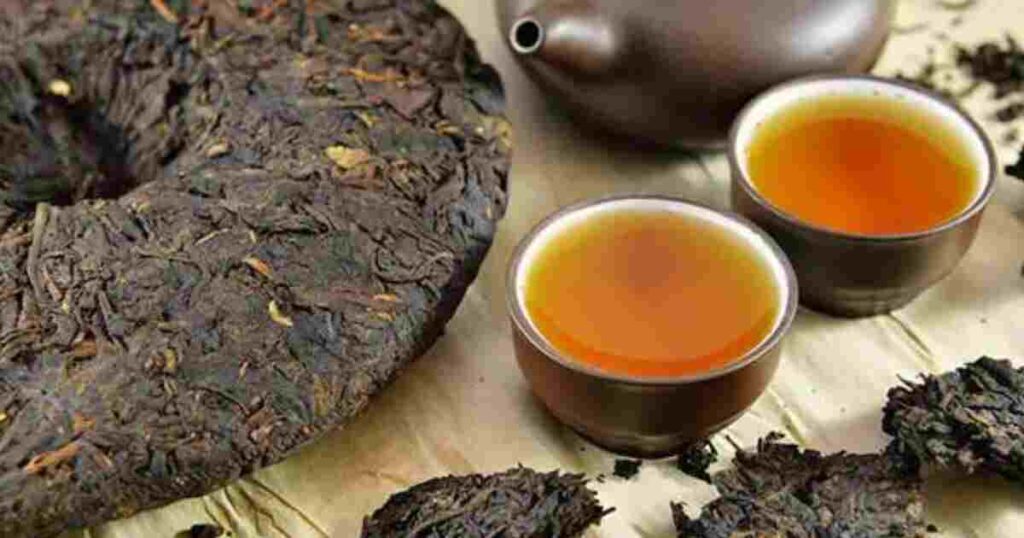Fermented Chinese tea Pu-erh is more than just a drink, it’s a centuries-old tradition that continues to grow in popularity around the world.
Sourced from Yunnan province in China, Pu-erh is a post-fermented tea known for its earthy flavor, rich aroma, and potential health benefits.
Unlike green or black tea, Pu-erh is aged and undergoes a unique fermentation process that gives it depth and character.
Tea lovers appreciate it not just for taste, but also for how it makes them feel—calm, refreshed, and sometimes even energized. Whether brewed fresh or aged for years, this tea has a unique quality that sets it apart.
What Makes Pu-erh Different?
Fermentation is what makes Pu-erh truly unique. After the tea leaves are harvested and dried, they go through microbial fermentation and oxidation.
This process can take months or even years. The longer the tea ages, the richer and smoother the flavor becomes.
There are two main types of Pu-erh: raw (Sheng) and ripe (Shou). Raw Pu-erh is aged naturally over time, sometimes for decades.
Ripe Pu-erh, on the other hand, undergoes an accelerated fermentation process that produces a mellow flavor in a shorter time. Both types offer their own unique qualities, but they share that signature earthy, slightly sweet taste.
Click here to learn more about Girnar Detox Desi Kahwa Green Tea Review.
Health Benefits of Fermented Chinese Tea Pu-erh
Many drinkers turn to fermented Chinese tea Pu-erh for more than just flavor. It has long been used in traditional Chinese medicine, and recent interest has sparked studies into its possible health effects.
Some known benefits include:
- Digestive support: Pu-erh may help with digestion by promoting healthy gut bacteria.
- Weight management: It is often linked with fat burning and metabolism support.
- Cholesterol control: Some studies suggest it can help lower LDL (bad) cholesterol.
- Mental clarity: Pu-erh contains caffeine, but in moderate levels, providing alertness without the crash.
The fermentation process is believed to increase the presence of probiotics, which support a healthy digestive system. This adds another layer of value to the tea, especially for those looking for a natural way to feel better daily.
Click here to learn more about whether green tea is good for kidney creatinine.
How to Brew Pu-erh Tea
Brewing Pu-erh is simple once you get the hang of it. You can use loose leaf or compressed tea (called a cake or brick). Here’s a quick guide to get you started:
- Rinse the tea: Pour hot water over the tea leaves, then quickly discard the liquid. This helps wake up the leaves and remove dust.
- Steep it: Add hot water again and steep for 20–30 seconds for the first infusion. You can adjust steeping time for stronger or lighter flavor.
- Re-steep: Pu-erh can be steeped multiple times—some drinkers get up to 10 or more brews from the same leaves.
You don’t need any fancy equipment, just quality tea and hot water. A small teapot or gaiwan works well, but a basic mug and strainer do the job too.
Click here to learn more about what Bi Luo Chun tea tastes like.
Where to Buy Quality Pu-erh Tea
Because fermented Chinese tea Pu-erh is aged, the quality can vary a lot. It’s important to buy from trusted sources, especially if you’re looking for authentic Chinese Pu-erh.
Look for sellers who specialize in Chinese teas and can tell you the origin, harvest date, and aging process.
Prices can range widely. Aged Pu-erh that has been stored properly for years will cost more, but even younger ripe Pu-erh can offer amazing flavor without breaking the bank.
Click here to learn more about the health benefits of Huangshan Maofeng tea.
Why People Are Falling in Love with Pu-erh
More people are discovering fermented Chinese tea Pu-erh not just for its taste but for how it becomes a daily ritual.
It brings a sense of calm and focus, whether you’re starting your morning or winding down at night. Each steep tells a story, and no two cups are quite the same.
As interest in traditional teas continues to grow, Pu-erh stands out for its depth, character, and connection to Chinese culture. Whether you’re new to tea or a long-time enthusiast, it’s worth adding to your collection.
Click here to learn more about Teatox Reviews consumer reports.
FAQs About Fermented Chinese Tea Pu-erh
What does Ferment Chinese tea Pu-erh taste like?
It has an earthy, woody flavor with subtle sweetness. Some aged varieties may also have notes of mushrooms, leather, or dried fruit.
Can you drink Pu-erh every day?
Yes, many people drink it daily. Just be mindful of the caffeine if you’re sensitive to it.
How long does Pu-erh last?
When stored properly in a cool, dry place, Pu-erh can last for decades. In fact, it often improves with age.
Does Pu-erh tea need sweeteners or milk?
Traditionally, Pu-erh is enjoyed plain. Its rich flavor stands on its own, though you can add honey or milk if you prefer.
Is Pu-erh the same as black tea?
No. Though both are oxidized, Pu-erh goes through an additional fermentation process, making it very different in taste and texture.
Where is fermented Chinese tea Pu-erh grown?
It is primarily grown in Yunnan province, China—an area known for its rich tea-growing heritage and climate ideal for tea trees.

